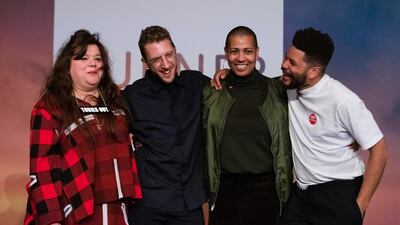On the cusp of receiving the nation’s top art prize, the four nominees decided to band together and espouse collectivity over competition, issuing a statement that encouraged the audience to focus on the “content of" their work rather than the public-relations exercise of the prize, which they split amongst themselves.
If you’re thinking I'm talking about the Turner Prize, which the four nominated artists accepted collectively on Tuesday night, you’re wrong — it was the 2017 Preis der Nationalgalerie, the pre-eminent German art prize, which Sol Calero, Iman Issa, Jumana Manna and Agnieszka Polska shared amongst the four of them.
Or maybe you’re excited the prize money was split among the shortlisted artists — well, that was also done by the American artist Theaster Gates in 2013, when he won the Artes Mundi prize (£40,000). Nope, nope, you’re definitely stoked about the Turner Prize. Maybe then remember the fact that Helen Marten, who won the Turner Prize in 2016, also shared the money with her fellow nominees.
So why is this year's Turner Prize such big news? So much is being claimed for it, with images of the artists – Tai Shani, Lawrence Abu Hamdan, Oscar Murillo, and Helen Cammock – coursing through social media, showing four happy faces, flushed with excitement over their moral victory.
Newspapers, art magazines, fashion magazines have all covered it, in varying degrees of adulation. And then the inevitable backlash: so these millennials just want a trophy for participation? Why did they accept the nomination, if they don’t like the idea of the prize? Four artists getting £10,000 each isn’t going to stop the Tories much, well is it? I can hear the shrieking of the keyboards from here.
It’s a wonderful gesture for the artists to have split the prize, honouring community at a time of political division. And it’s especially poignant for the UK, in which both good news and unselfish courage have lately been in short supply. People want to hear it, and it’s also a narrative they expect — and which has been missing — from the Turner Prize in particular.
The Turner Prize, organised by Tate Britain and running since 1984, occupies an outsize influence in the British art world because it is so closely associated with the Young British Artists of the 1990s.
Much of the artwork of the YBAs, as they were known, has now been disavowed — either because it was simply looking for shock value, or because of its petty nationalism — but there was an enthusiasm and a verve to it that is sorely lacking in today’s environment. Symbolically, the Turner was the epitome of the YBA phenomenon — steeped in the ethos of neoliberal competition, a stage set for the cameras, and accompanied by myriad libations.
It’s not fair to say the Turner has lost its mojo since the YBAs receded from view in the 2000s. If anything, it’s moved with the times: with the nomination of Forensic Architecture, last year, the judges proved they were altogether happy to forget static notions of what constitutes art (Forensic Architecture are more properly described as a research team).
The number of women and people of colour nominated is steadily growing. This year included what could have been the first Arab winner: the Lebanese-British artist Lawrence Abu Hamdan, who accepted his co-honour wearing clothes from Qasimi, the fashion house set up by the late Khalid bin Sultan Al Qasimi, the son of Sharjah’s Sheikh Sultan bin Mohammed Al Qasimi, which is now run by his twin sister, Hoor Al Qasimi.
But people still want headlines from the Turner, and this year delivered it. More importantly, the artists delivered it to a platform of people who are hungry for heroes: a leftist art audience that feels so alienated and disenfranchised they will latch on to any glimmer of positivity or individual willing to make a dent in the dispersion of power and money.
How many people, just this year, have been pushed up the cyclone of social-media affirmation in order to appear like the second-coming of social progressivism? Princess Anne blanking President Trump at Buckingham Palace? The guy who heckled Boris Johnson in Leeds? The Lebanese soldier who cried in support of the protesters in Beirut?
There’s a financial incentive to our anxiety: Silicon Valley, and even the traditional media, profit from hype, as numerous studies and leaks now make unflinchlingly clear. The good feeling we get by endorsing gestures of solidarity does not outweigh the larger harm of participating in an emotionally manipulative social-media culture.
Well done to this year’s four artists, but let’s not let our excitement obscure the larger picture of what — indeed — needs to be done to tamp down social division.


